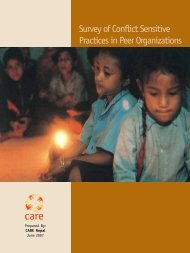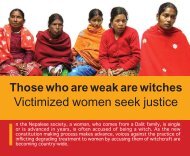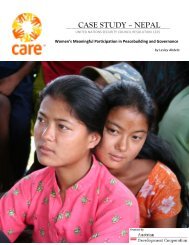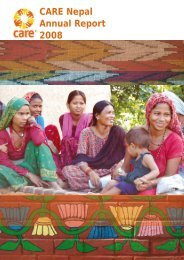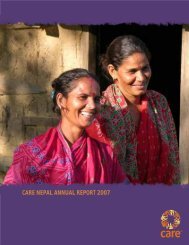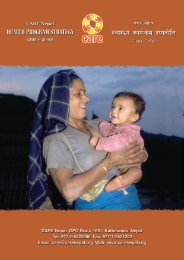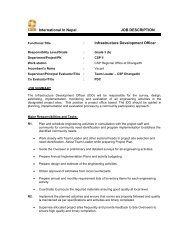Untitled - Care Nepal
Untitled - Care Nepal
Untitled - Care Nepal
You also want an ePaper? Increase the reach of your titles
YUMPU automatically turns print PDFs into web optimized ePapers that Google loves.
husbands, criticism in unnecessary issues<br />
and restriction in mobility were the major<br />
threats to women’s psychosocial well-being.<br />
Domestic violence was reported<br />
widespread in our research districts. Earlier<br />
research has shown that domestic violence<br />
is especially linked closely to alcohol abuse<br />
and committed by men (N Bhardwaj, SK<br />
Dhungana, N Hicks, R Crozier, C -<br />
Kathmandu: Friends for Peace and<br />
International Alert, 2007). Equally,<br />
economical issues hamper women’s wellbeing.<br />
Since the majority of the research<br />
participants were from economically lower<br />
status (ie land less women), they had to work<br />
hard from morning until evening in others<br />
field to fulfill their family members needs.<br />
Due to which they felt physically and<br />
mentally tired. They were not able to<br />
manage the minimum demands of their<br />
children.<br />
In the context of <strong>Nepal</strong> usually people are<br />
not aware of psychosocial issues. But this<br />
research has identified lot of symptoms and<br />
perceived causes of psychosocial problems<br />
of women. Psychosocial problems were<br />
mentioned by a majority of the women in<br />
all four research districts even though<br />
perceived causes were somewhere<br />
different.<br />
In terms of coping mechanism it was found<br />
that women mostly share their insights,<br />
feelings and emotions with their close<br />
friends while they are together. The pathway<br />
model presented above provides a clear<br />
picture of how women cope with the<br />
psychosocial problems and perceived<br />
support from family and community level.<br />
Previous research has shown the importance<br />
of such social support processes (James<br />
Goodhand, David Rampton, 2008).<br />
Likewise in this research, it was found that<br />
some of the culture of community such as<br />
saving groups, women groups were<br />
supportive factors from where women got<br />
support to solve the problems. Despite the<br />
exclusion and marginalization of many<br />
groups of women from socio-political and<br />
economic areas in <strong>Nepal</strong>, women groups<br />
and local CBOs remained active at the<br />
community level. Additionally, women<br />
groups more concentrated to reduce the<br />
gender based violence in community level<br />
(N BHARADWAJ, SK Dhungana, N Hicks,<br />
R Crozier, C..- Kathmandu: Friends for<br />
Peace and International Alert, 2007). On<br />
the other side, rituals, traditions such as<br />
restriction during the menstruation period,<br />
lack of freedom in the mobility and<br />
conservative mind set up were explained as<br />
the disempowering factors. Such findings<br />
have been reported elsewhere as well. For<br />
instance, research has shown that women<br />
living in poor social and environmental<br />
circumstances with associated low<br />
education, low income and difficult family<br />
and marital relationships, are much more<br />
likely than other women to suffer from<br />
mental disorders. E.g. Blue and colleagues<br />
(1995) conclude that the combined impact<br />
of gender and low social-economic status<br />
are critical determinants of mental ill-health<br />
(Blue et al, 1995).<br />
Psychosocial Issues of<br />
Women affected by conflict<br />
35



